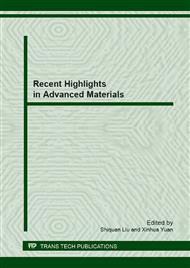[1]
M. Johnson, T. Timothy, D. Fullwood, G. Hansen, Strain monitoring of carbon fiber composite via embedded nickel nano-particles, Composites Part B-Engineering, 43(2012) 1155-1163.
DOI: 10.1016/j.compositesb.2011.09.014
Google Scholar
[2]
E. Ghafoori, A. Schumacher, M. Motavalli, Fatigue behavior of notched steel beams reinforced with bonded CFRP plates: Determination of prestressing level for crack arrest, Engineering Structures , 45 (2012) 270-283.
DOI: 10.1016/j.engstruct.2012.06.047
Google Scholar
[3]
J. Michels, C. Czaderski, R. El-Hacha, Temporary bond strength of partly cured epoxy adhesive for anchoring prestressed CFRP strips on concrete, Composite Structures , 94 (2012) 2667-2676.
DOI: 10.1016/j.compstruct.2012.03.037
Google Scholar
[4]
S.R. Zhu, D.D.L. Chung, Analytical model of piezoresistivity for strain sensing in carbon fiber polymer–matrix structural composite under flexure, Carbon, 45 (2007) 1606-1613.
DOI: 10.1016/j.carbon.2007.04.012
Google Scholar
[5]
A. Faezeh, B. Nemkumar, Cement-based sensors with carbon fibers and carbon nanotubes for piezoresistive sensing, Cement & Concrete Composites, 34 (2012) 866-873.
DOI: 10.1016/j.cemconcomp.2012.04.007
Google Scholar
[6]
B. G. Han, X.C. Guan, J.P. Ou. Electrode design, measuring method and data acquisition system of carbon fiber cement paste piezoresistive sensors, Sensors and Actuators A, 135 (2007)360-369.
DOI: 10.1016/j.sna.2006.08.003
Google Scholar
[7]
A. Boschetti-de-Fierro, R. Pardey, V. Savino, Piezoresistive behavior of epoxy matrix-carbon fiber composites with different reinforcement arrangements, J of Appl Polym Sci, 111 (2009) 2851–2858.
DOI: 10.1002/app.29335
Google Scholar
[8]
L. L. Yang, Y. Ge, Q.H. Zhu, C. Zhang, Z. P. Wang, and P.H. Liu. Experimental and numerical studies on the sensitivity of carbon fibre/silicone rubber composite sensors, Smar Mater Struct, 21(2012) 035011.
DOI: 10.1088/0964-1726/21/3/035011
Google Scholar
[9]
X. J. Wang, D.D.L. Chung. Short carbon fiber reinforced epoxy coating as a piezoresistive strain sensor for cement mortar, Sensor and Actuator A, 71(1998) 208-210.
DOI: 10.1016/s0924-4247(98)00187-3
Google Scholar
[10]
D. Liu, Z.Q. Li, X.H. Song, S.R. Zhu, H.S. Zheng. Research on the Strain-sensing Stability of Polymer Based Carbon Fiber Composite, J of Wuhan University of Technology, 30 (2008) 8-10.
Google Scholar


